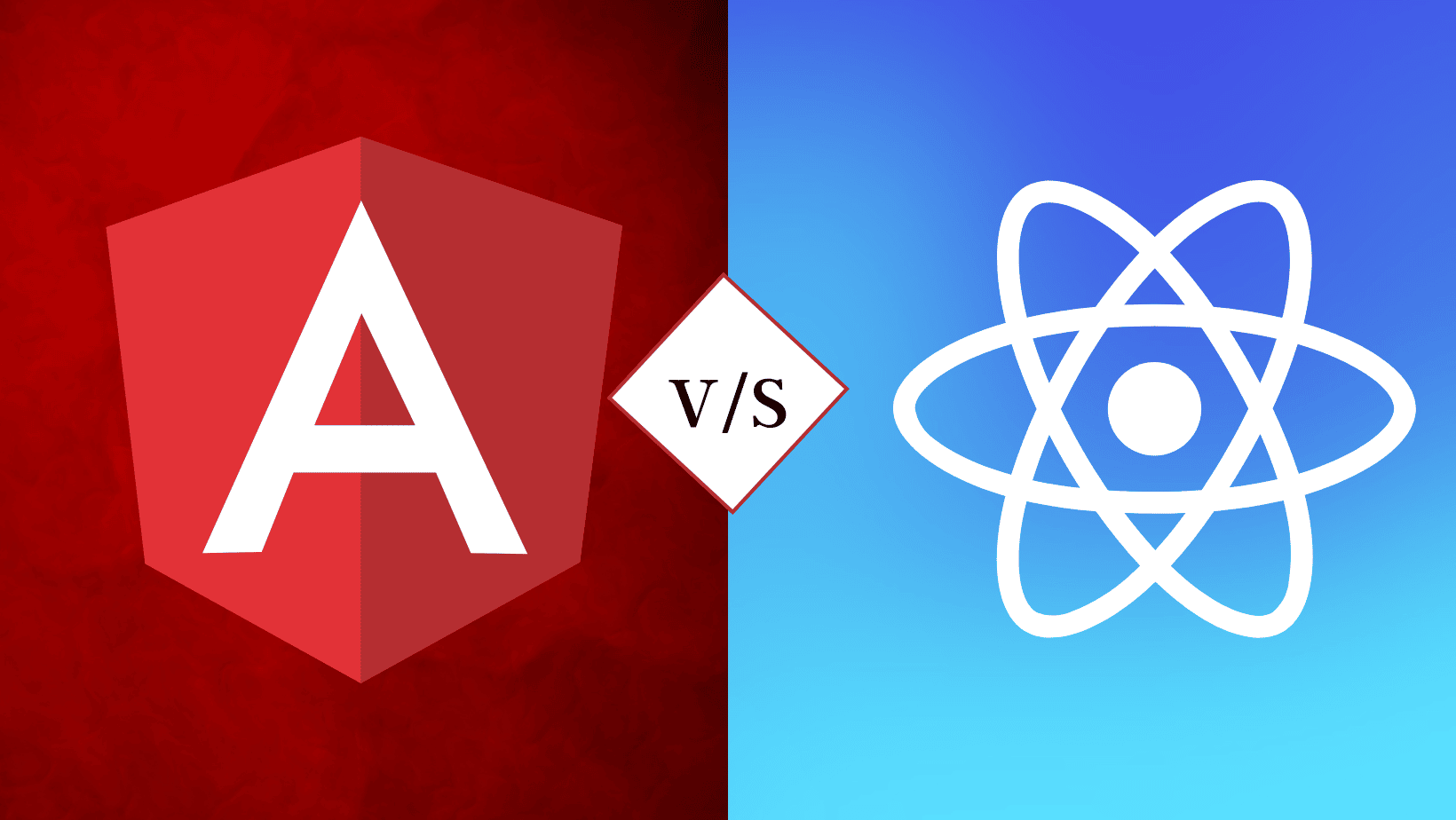This is not merely Angular Vs React but it’s Google vs Facebook. The two technologies are as different as Google and Facebook themselves. Angular is a full fledged framework, while React is a library although React is advanced enough to include the necessary libraries to be called a development framework as well. Angular vs React has been a matter of debate for a long time. Especially when you have many other options available to choose from for your project. You have got to understand what exactly is your requirement ; which one would fit the bill. We will understand this later in the blog: what they are and how the two differ from each other.
What is Angular?
Angular is an open source (Can be downloaded and modified for free) framework mainly used to create web apps, single page web apps, hybrid mobile apps and large scale applications. It’s a comprehensive application design framework development platform ;built using Typescript and developed and maintained by Google. Gmail, YouTube TV, and Udacity all use Angular in their technology stacks.
What is React?
React is a front-end JavaScript Library; a high performance UI (user interface) library developed and maintained by Facebook. It can help build rich and complex applications by facilitating block building components for users to use them as and when required in their applications. React allows you to have a sneak peak of what the UI is going to appear like eventually. Developers who know JavaScript ; it’s easier for them to play around with React. Instagram, Facebook, and Netflix are some examples of apps built with React.
Niche Digital Solutions
Our development team at Simpalm can transform your business with high-end and performance-driven applications leveraging trending technologies.
Strategy
Design
Development
Support
Detailed Comparison: React vs Angular
1. React vs Angular Structure
React is a JavaScript library whereas Angular is a frontend framework. Both Angular and React are component based; where they differ is in how they implement componentization. In the Angular world, components are decorators (@component); functions that enable a service, directive, or filter to be pre-cooked before their usage. They allow us to tell if a class is a module or component and pull the necessary metadata together to determine how a view should be rendered. In React, components are actually JSX files that contain both JavaScript and HTML templating in a single file. These components can be class based or pure functions depending on the needs of the developer.
2. React vs Angular DOM (Document Object Model) Comparison
Both React and Angular use DOM. Angular uses Real DOM on the other hand React uses Virtual DOM. In Angular, when a modification is made the entire tree structure updates. React can implement changes in a single component without updating the entire tree structure.
3. React vs Angular Performance
The two front-end technologies have been nip and tuck in terms of performance benchmark. Performance is comparable for most general metrics. Depending on the version or test, sometimes either React or Angular will come out ahead. Angular tends to perform better overall for task-based benchmark tests. React does seem to show an advantage when you look at overall load time. This makes sense because React uses a virtual DOM to efficiently load specific parts of a webpage while Angular manipulates the DOM directly (which is resource intensive).
Remember that Angular uses Real DOM while React uses Virtual DOM, now let’s take an example . Let’s say I want to update my First name in my profile; In Angular it would update the entire HTML doc until it reaches the required field; in our case it’s First name. Whereas in React it will update only the desired field and not the entire HTML doc; that takes React ahead of Angular when it comes to faster performance.
If you are developing an Application that requires frequent updates , Angular might not be the good choice but if you are into developing something that requires updates occasionally Angular is Perfect. Upwork got around 10 M of users and uses Angular because the users occasionally require feeds to be updated. Whereas Instagram uses React because user’s feeds are required to be updated very frequently, so if you need frequent updates React is the best choice.
4. React Vs Angular Data Binding
Data binding is the mechanism that connects the data model to the View/UI of the Application. React has one way data binding and Angular has two way data binding. Two way data binding may be nice for small to medium size applications to manage the application state but when the application scales it might get trickier to catch the actual spot of the issues/errors. So there are chances of unintended side effects. In one way data binding since the data model is the only source of truth so it becomes easier to manage the state across the applications even in the case of large scale applications. Angular two way data binding might seems to be easier but Reacts one way data binding is more effective approach for the projects with huge amount of codes.
5. React Vs Angular Learning Curve
React is relatively easy to learn. Angular has a relatively steep curve. For the enterprise level projects the learning curve and the time might not be a big deal so Angular could be a good choice . For the projects standing on their hot foot; learning curve and the cost is more crucial so better to go with React.
Also Read: Best Frontend Frameworks and Technologies 2022
Why Angular for Your Next Mobile App project?
Not only Angular does have tons of embellishments but it’s also packed with components and features that enhance the pace of Application development. Being developed by Google ; the framework is reliable and effective. A few bonus using Angular:
- Angular treats everything inside it as a component that can be thought of as a lego set, every component is a kingdom in itself and has unique properties that can be taken from one place to another to be used.
- IVY renderer that converts Typescript and HTML into JavaScript while the App is being built and before it goes to browser, another benefit of IVY is that it declutters the code that is not required by the current Apps and thus improves the speed and performance of the App while it’s up and live.
- Components in Angular are mutually exclusive of each other when not in action , so one component can easily be taken out and put something more advanced in its place. That’s the beauty of the component and scalability in Angular. The componentization also facilitates the maintenance by spotting the actual component having issues.
- Knowing the right CLI (Command line Interface) can be of huge use for developers wanting to install new versions, deploy Apps live, ensure there are no bugs in a matter of seconds.
- Angular has a vast developer community.
Why React for your next Mobile App project?
It enhances the view layer of the App and it’s quick and scalable. React changes the data without reloading the page. Following are the key nodes that distinguish react from others:
-
- React is easier to learn.
- React has JSX that creates shortcuts for the JavaScript and thus makes it a faster development platform that can save time and money.
- React provides reusable components; those have their own logic and can be reused whenever required.
- One way data binding also plays a key role when it comes to state management is that developers love to have to be focused on what has changed for what. This ensures better application management since one change would not impact the entire code.
- React flaunts its performance using virtual DOM.
- Strong community support is also a spot for developers to be attracted to React
Read More: What is React Native and Why Choose it for AI-Powered Business Apps
Which One to Choose
Both Angular and Reacts are wonderful frameworks, both have tons of advantages. The timely changes , improvements and updates show positive growth for both of them. When it comes to choosing one; you should choose the Angular framework when developing a large-scale Application,Single page Applications (SPAs). It gives you a reliable and scalable framework.
React can be used when developing a cross platform App or you need to extend the capabilities of existing Applications. With React it is quite easier to develop a lightweight yet modern application. React facilitates development with a lot of tools and extendable libraries that can be included to personalize your App.
Making a decision on any of the two will still depend on the skillsets of the developers, architecture of the application, and the overall complexity of the project. Partnering with a team that offers end-to-end mobile app development services can help businesses choose the right technology and build scalable, high-performance applications..

 App Development
App Development Web Engineering
Web Engineering AI Services
AI Services Startups
Startups Health / Fitness
Health / Fitness Education
Education Social
Social Nonprofit
Nonprofit Fintech
Fintech Logistics
Logistics Government
Government HR Software
HR Software About Simpalm
About Simpalm Our News
Our News Client Testimonials
Client Testimonials Careers
Careers Awards
Awards Resources
Resources Information
Information



One Response to Angular Vs React: Which One to Choose for your Next Project